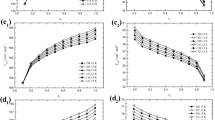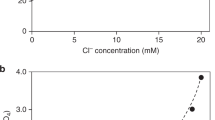Abstract
1-Ethyl-3-methylimidazolium acetate (EMIMAc) is an ionic liquid (IL) often investigated as a solvent, especially in the context of biopolymers and biomass pretreatment. A reduced solvent efficacy occurs upon the addition even of low amounts of water to EMIMAc. Molecular mechanisms have not yet been fully understood. It is expected that the functionality as hydrogen bond donor and acceptor is key for the solvent–solute interactions. In this work, we analyze the solvent efficacy of EMIMAc in terms of hydrogen–deuterium (H/D) exchange at the C(2)-position in mixtures with water or acetic acid added as proton donors. Low-field NMR spectroscopy and deuterated solvents are used for a time-resolved evaluation of H/D exchange reactions. The H/D exchange is also modeled to explore changes in the reaction kinetics as a function of the mixture composition. The significant difference in calculated rate constant values among the concentration regimes shows that the chosen model equations of a possible pseudo-first-order and second-order reaction mechanism including water dissociation do not cover all interaction phenomena that influence the exchange in the individual concentration ranges. However, the modeling also indicates that the investigated interaction of \(\hbox {EMIM}^+\) and \(\hbox {Ac}^-\) remains constant for concentrated IL mixtures containing \(70\, {\text{mol}}\%\) of EMIMAc in water up to diluted mixtures as low as \(30\, {\text{mol}}\%\) EMIMAc. This exemplifies the change between ions strongly associated in networks in concentrated mixtures suitable for biomass pretreatment and the much less associated anion–cation pairs in diluted mixtures which leads to the decreased efficiency of EMIMAc with increasing water content.






Similar content being viewed by others
References
Viell, J., Wulfhorst, H., Schmidt, T., Commandeur, U., Fischer, R., Spiess, A., Marquardt, W.: An efficient process for the saccharification of wood chips by combined ionic liquid pretreatment and enzymatic hydrolysis. Bioresour. Technol. 146, 144–151 (2013). https://doi.org/10.1016/j.biortech.2013.07.059
Swatloski, R.P., Spear, S.K., Holbrey, J.D., Rogers, R.D.: Dissolution of cellose with ionic liquids. J. Am. Chem. Soc. 124(18), 4974–4975 (2002). https://doi.org/10.1021/ja025790m
Sun, N., Rahman, M., Qin, Y., Maxim, M.L., Rodríguez, H., Rogers, R.D.: Complete dissolution and partial delignification of wood in the ionic liquid 1-ethyl-3-methylimidazolium acetate. Green Chem. 11(5), 646–655 (2009). https://doi.org/10.1039/b822702k
Kilpeläinen, I., Xie, H., King, A., Granstrom, M., Heikkinen, S., Argyropoulos, D.S.: Dissolution of wood in ionic liquids. J. Agric. Food Chem. 55(22), 9142–9148 (2007). https://doi.org/10.1021/jf071692e
Viell, J., Inouye, H., Szekely, N.K., Frielinghaus, H., Marks, C., Wang, Y., Anders, N., Spiess, A.C., Makowski, L.: Multi-scale processes of beech wood disintegration and pretreatment with 1-ethyl-3-methylimidazolium acetate/water mixtures. Biotechnol. Biofuels 9, 7 (2016). https://doi.org/10.1186/s13068-015-0422-9
Lovell, C.S., Walker, A., Damion, R.A., Radhi, A., Tanner, S.F., Budtova, T., Ries, M.E.: Influence of cellulose on ion diffusivity in 1-ethyl-3-methyl-imidazolium acetate cellulose solutions. Biomacromolecules 11(11), 2927–2935 (2010). https://doi.org/10.1021/bm1006807
Le, K.A., Rudaz, C., Budtova, T.: Phase diagram, solubility limit and hydrodynamic properties of cellulose in binary solvents with ionic liquid. Carbohydr. Polym. 105, 237–243 (2014). https://doi.org/10.1016/j.carbpol.2014.01.085
Rabideau, B.D., Agarwal, A., Ismail, A.E.: The role of the cation in the solvation of cellulose by imidazolium-based ionic liquids. J. Phys. Chem. B 118(6), 1621–1629 (2014). https://doi.org/10.1021/jp4115755
Lu, B., Xu, A., Wang, J.: Cation does matter: how cationic structure affects the dissolution of cellulose in ionic liquids. Green Chem. 16(3), 1326–1335 (2014). https://doi.org/10.1039/c3gc41733f
Xu, A., Wang, J., Wang, H.: Effects of anionic structure and lithium salts addition on the dissolution of cellulose in 1-butyl-3-methylimidazolium-based ionic liquid solvent systems. Green Chem. 12(2), 268–275 (2010). https://doi.org/10.1039/b916882f
Brandt, A., Hallett, J.P., Leak, D.J., Murphy, R.J., Welton, T.: The effect of the ionic liquid anion in the pretreatment of pine wood chips. Green Chem. 12(4), 672–679 (2010). https://doi.org/10.1039/b918787a
Ebner, G., Schiehser, S., Potthast, A., Rosenau, T.: Side reaction of cellulose with common 1-alkyl-3-methylimidazolium-based ionic liquids. Tetrahedron Lett. 49(51), 7322–7324 (2008). https://doi.org/10.1016/j.tetlet.2008.10.052
Clough, M.T., Geyer, K., Hunt, P.A., Son, S., Vagt, U., Welton, T.: Ionic liquids-not always innocent solvents for cellulose. Green Chem. 17(1), 231–243 (2015). https://doi.org/10.1039/c4gc01955e
Xu, A., Zhang, Y., Zhao, Y., Wang, J.: Cellulose dissolution at ambient temperature: role of preferential solvation of cations of ionic liquids by a cosolvent. Carbohydr. Polym. 92(1), 540–544 (2013). https://doi.org/10.1016/j.carbpol.2012.09.028
Brehm, M., Weber, H., Pensado, A.S., Stark, A., Kirchner, B.: Proton transfer and polarity changes in ionic liquid–water mixtures: a perspective on hydrogen bonds from ab initio molecular dynamics at the example of 1-ethyl-3-methylimidazolium acetate–water mixtures-part 1. Phys. Chem. Chem. Phys. 14(15), 5030–5044 (2012). https://doi.org/10.1039/c2cp23983c
Hollóczki, O., Gerhard, D., Massone, K., Szarvas, L., Németh, B., Veszprémi, T., Nyulászi, L.: Carbenes in ionic liquids. New J. Chem. 34(12), 3004–3009 (2010). https://doi.org/10.1039/c0nj00380h
MacFarlane, D.R., Pringle, J.M., Johansson, K.M., Forsyth, S.A., Forsyth, M.: Lewis base ionic liquids. Chem. Commun. 18, 1905–1917 (2006). https://doi.org/10.1039/b516961p
Vilarino, T., de Vicente, M.E.S.: Theoretical calculations of the ionic strength dependence of the ionic product of water based on a mean spherical approximation. J. Solution Chem. 26(9), 833–846 (1997). https://doi.org/10.1007/BF02768261
McCune, J.A., He, P., Petkovic, M., Coleman, F., Estager, J., Holbrey, J.D., Seddon, K.R., Swadźba-Kwaśny, M.: Brønsted acids in ionic liquids: how acidity depends on the liquid structure. Phys. Chem. Chem. Phys. 16(42), 23233–23243 (2014). https://doi.org/10.1039/c4cp03217a
MacFarlane, D.R., Chong, A.L., Forsyth, M., Kar, M., Vijayaraghavan, R., Somers, A., Pringle, J.M.: New dimensions in salt–solvent mixtures: a 4th evolution of ionic liquids. Faraday Discuss. 206, 9–28 (2018). https://doi.org/10.1039/c7fd00189d
Baek, C.S., Lee, Y.J., Lee, S.J., Kim, H.C., Jeong, S.W.: C2-Functionalized 1,3-dialkylimidazolium ionic liquids for efficient cellulose dissolution. J. Mol. Liq. 234, 111–116 (2017). https://doi.org/10.1016/j.molliq.2017.03.086
Yoshimura, Y., Hatano, N., Takekiyo, T., Abe, H.: Direct correlation between the H/D exchange reaction and conformational changes of the cation in imidazolium-based ionic liquid-D\(_2\)O mixtures. J. Solution Chem. 43(9–10), 1509–1518 (2014). https://doi.org/10.1007/s10953-014-0181-4
Cha, S., Ao, M., Sung, W., Moon, B., Ahlström, B., Johansson, P., Ouchi, Y., Kim, D.: Structures of ionic liquid–water mixtures investigated by IR and NMR spectroscopy. Phys. Chem. Chem. Phys. 16(20), 9591–9601 (2014). https://doi.org/10.1039/c4cp00589a
Yasaka, Y., Wakai, C., Matubayasi, N., Nakahara, M.: Slowdown of H/D exchange reaction rate and water dynamics in ionic liquids: deactivation of solitary water solvated by small anions in 1-butyl-3-methyl-imidazolium chloride. J. Phys. Chem. A 111(4), 541–543 (2007). https://doi.org/10.1021/jp0673720
Rico Del Cerro, D., Mera-Adasme, R., King, A.W.T., Perea-Buceta, J.E., Heikkinen, S., Hase, T., Sundholm, D., Wähälä, K.: On the mechanism of the reactivity of 1,3-dialkylimidazolium salts under basic to acidic conditions: a combined kinetic and computational study. Angew. Chem. Int. Ed. 57(36), 11613–11617 (2018). https://doi.org/10.1002/anie.201805016
Ohta, S., Shimizu, A., Imai, Y., Abe, H., Hatano, N., Yoshimura, Y.: Peculiar concentration dependence of H/D exchange reaction in 1-butyl-3-methylimidazolium tetrafluoroborate-D\(_2\)O mixtures. Open J. Phys. Chem. 01(03), 70–76 (2011). https://doi.org/10.4236/ojpc.2011.13010
Allen, J.J., Bowser, S.R., Damodaran, K.: Molecular interactions in the ionic liquid emim acetate and water binary mixtures probed via NMR spin relaxation and exchange spectroscopy. Phys. Chem. Chem. Phys. 16(17), 8078–8085 (2014). https://doi.org/10.1039/c3cp55384a
Horikawa, Y., Sugiyama, J.: Accessibility and size of Valonia cellulose microfibril studied by combined deuteration/rehydrogenation and FTIR technique. Cellulose 15(3), 419–424 (2008). https://doi.org/10.1007/s10570-007-9187-z
Reishofer, D., Spirk, S.: Deuterium and cellulose: A comprehensive review. Adv. Polym. Sci. 271, 93–114 (2016). https://doi.org/10.1007/12_2015_321
Pönni, R., Rautkari, L., Hill, C.A.S., Vuorinen, T.: Accessibility of hydroxyl groups in birch kraft pulps quantified by deuterium exchange in D\(_2\)O vapor. Cellulose 21(3), 1217–1226 (2014). https://doi.org/10.1007/s10570-014-0166-x
Suchy, M., Kontturi, E., Vuorinen, T.: Impact of drying on wood ultrastructure: similarities in cell wall alteration between native wood and isolated wood-based fibers. Biomacromolecules 11(8), 2161–2168 (2010). https://doi.org/10.1021/bm100547n
Jiang, Z., Fan, J., Budarin, V.L., Macquarrie, D.J., Gao, Y., Li, T., Hu, C., Clark, J.H.: Mechanistic understanding of salt-assisted autocatalytic hydrolysis of cellulose. Sustain. Energy Fuels 2(5), 936–940 (2018). https://doi.org/10.1039/C8SE00045J
Hishikawa, Y., Togawa, E., Kataoka, Y., Kondo, T.: Characterization of amorphous domains in cellulosic materials using a FTIR deuteration monitoring analysis. Polymer 40(25), 7117–7124 (1999). https://doi.org/10.1016/S0032-3861(99)00120-2
Wahba, M.: Kinetics of the deuteration of cellulose: An infrafred study with D\(_2\)O–H\(_2\)O vapours. Chem. Scr. 11(4–5), 158–163 (1977)
Mullangi, V., Zhou, X., Ball, D.W., Anderson, D.J., Miyagi, M.: Quantitative measurement of the solvent accessibility of histidine imidazole groups in proteins. Biochemistry 51(36), 7202–7208 (2012). https://doi.org/10.1021/bi300911d
Amyes, T.L., Diver, S.T., Richard, J.P., Rivas, F.M., Toth, K.: Formation and stability of n-heterocyclic carbenes in water: the carbon acid pK\(_a\) of imidazolium cations in aqueous solution. J. Am. Chem. Soc. 126(13), 4366–4374 (2004). https://doi.org/10.1021/ja039890j
Bai, Y., Milne, John S., Mayne, Leland, Englander, S.W.: Primary structure effects on peptide group hydrogen exchange. Proteins 17, 75–88 (1993). https://doi.org/10.1002/prot.340170110
Amyes, T.L., Richard, J.P.: Determination of the pK \(_a\) of ethyl acetate: Brønsted correlation for deprotonation of a simple oxygen ester in aqueous solution. J. Am. Chem. Soc. 118, 3129–3141 (1996). https://doi.org/10.1021/ja953664v
Walz, O., Marks, C., Viell, J., Mitsos, A.: Systematic approach for modeling reaction networks involving equilibrium and kinetically-limited reaction steps. Comput. Chem. Eng. 98, 143–153 (2017). https://doi.org/10.1016/j.compchemeng.2016.12.014
Khan, I., Kurnia, K.A., Mutelet, F., Pinho, S.P., Coutinho, J.A.P.: Probing the interactions between ionic liquids and water: experimental and quantum chemical approach. J. Phys. Chem. B 118(7), 1848–1860 (2014). https://doi.org/10.1021/jp4113552
Simoni, L.D., Brennecke, J.F., Stadtherr, M.A.: Asymmetric framework for predicting liquid\(-\)liquid equilibrium of ionic liquid–mixed-solvent systems. 1. Theory, phase stability analysis, and parameter estimation. Ind. Eng. Chem. Res 48(15), 7246–7256 (2009). https://doi.org/10.1021/ie900461j
Chen, Y., Li, S., Xue, Z., Hao, M., Mu, T.: Quantifying the hydrogen-bonding interaction between cation and anion of pure [EMIM][Ac] and evidencing the ion pairs existence in its extremely diluted water solution: Via \(^{13}\)C, \(^1\)H, \(^{15}\)N and 2D NMR. J. Mol. Struct. 1079, 120–129 (2015). https://doi.org/10.1016/j.molstruc.2014.09.023
Hall, C.A., Le, K.A., Rudaz, C., Radhi, A., Lovell, C.S., Damion, R.A., Budtova, T., Ries, M.E.: Macroscopic and microscopic study of 1-ethyl-3-methyl-imidazolium acetate–water mixtures. J. Phys. Chem. B 116(42), 12810–12818 (2012). https://doi.org/10.1021/jp306829c
Chen, Y., Cao, Y., Sun, X., Mu, T.: Hydrogen bonding interaction between acetate-based ionic liquid 1-ethyl-3-methylimidazolium acetate and common solvents. J. Mol. Liq. 190, 151–158 (2014). https://doi.org/10.1016/j.molliq.2013.11.010
Wong, J.L., Keck, J.H.: Positional reactivities and mechanisms of deuteration of 1-methylimidazole in pD and -D\(_0\) regions. Reinvestigation of the kinetics of 2-hydrogen exchange in imidazole. J. Org. Chem 39(16), 2398–2403 (1974). https://doi.org/10.1021/jo00930a015
Hatano, N., Watanabe, M., Takekiyo, T., Abe, H., Yoshimura, Y.: Anomalous conformational change in 1-butyl-3-methylimidazolium tetrafluoroborate–D\(_2\)O mixtures. J. Phys. Chem. A 116(4), 1208–1212 (2012). https://doi.org/10.1021/jp2097873
Chen, Y., Cao, Y., Zhang, Y., Mu, T.: Hydrogen bonding between acetate-based ionic liquids and water: three types of IR absorption peaks and NMR chemical shifts change upon dilution. J. Mol. Struct. 1058, 244–251 (2014). https://doi.org/10.1016/j.molstruc.2013.11.010
Kar, M., Plechkova, N.V., Seddon, K.R., Pringle, J.M., MacFarlane, D.R.: Ionic liquids: further progress on the fundamental issues. Aust. J. Chem. 72(2), 3 (2019). https://doi.org/10.1071/CH18541
Armand, M., Endres, F., MacFarlane, D.R., Ohno, H., Scrosati, B.: Ionic-liquid materials for the electrochemical challenges of the future. Nat. Mater. 8(8), 621–629 (2009). https://doi.org/10.1038/nmat2448
MacFarlane, D.R., Tachikawa, N., Forsyth, M., Pringle, J.M., Howlett, P.C., Elliott, G.D., Davis, J.H., Watanabe, M., Simon, P., Angell, C.A.: Energy applications of ionic liquids. Energy Environ. Sci. 7(1), 232–250 (2014). https://doi.org/10.1039/C3EE42099J
Acknowledgements
This work was funded by the Deutsche Forschungsgemeinschaft (DFG, German Research Foundation) under Germany’s Excellence Strategy - Exzellenzcluster 236 “Tailor-Made Fuels from Biomass”. We thank our colleagues Olga Walz and Luisa Brée for their support concerning the modeling part of this study. We would also like to thank Prof. Walter Leitner for fruitful discussions.
Author information
Authors and Affiliations
Corresponding author
Additional information
Publisher's Note
Springer Nature remains neutral with regard to jurisdictional claims in published maps and institutional affiliations.
Electronic supplementary material
Below is the link to the electronic supplementary material.
Rights and permissions
About this article
Cite this article
Marks, C., Mitsos, A. & Viell, J. Change of C(2)-Hydrogen–Deuterium Exchange in Mixtures of EMIMAc. J Solution Chem 48, 1188–1205 (2019). https://doi.org/10.1007/s10953-019-00899-7
Received:
Accepted:
Published:
Issue Date:
DOI: https://doi.org/10.1007/s10953-019-00899-7




